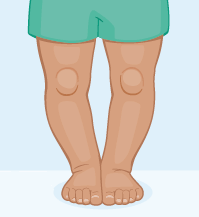
Do your child have bowed legs like like this? Did you know that there are chances that it could be a child-hood disorder known as Rickets. But don’t worry. Most of the time it turns out to be Bowed Legs (Blount’s Disease) which is very common in children under 3 years and will gradually get corrected when he/she grows up.
Bow legs (or genu varum) is when the legs curve outward at the knees while the feet and ankles touch. Infants and toddlers often have bow legs. Sometimes, older kids do too. It’s rarely serious and usually goes away without treatment, often by the time a child is 3–4 years old.
The main reason for Rickets is not able to absorb Calcium due to the lack of Vitamin D. This is a common case in middle east and usually associated with living inside apartments where there is not enough sunlight.
It is recommended for all children to supplement with oral vitamin D-drops after birth
You can get a Vitamin D test from home by clicking here.
There are three major types of rickets are distinguished:
• Renal osteodystrophy, in which the kidneys fail to maintain blood levels of calcium and phosphorus.
• Vitamin D‒resistant or hypophosphatemic rickets, which is a genetic disorder characterized by low phosphate levels unrelated to intake or vitamin D status
• Nutritional rickets stemming from deficiency of intake of dietary vitamin D, calcium, and/or phosphate during childhood – the most common form
Globally, rickets is most commonly found in children between 6 months and 24 months of age.
Findings associated with prolonged and extreme deficient intake typically include muscle weakness; delayed growth; pain in the legs, pelvis, and spine; and significant skeletal deformities. A child with rickets may display projection of the breastbone, thickened ankles and wrists, and bowed legs.
It’s always best to consult your pediatrician and get an x-ray done to check whether the child has got some skeletal disorder and treat it with proper vitamins and calcium.
We do pediatric physiotherapy for cases who suffer from disabilities , deformities and other pediatrics conditions using splints, braces ,swiss ball exercises and other effective treatment.
Tip: Let your children be in the sun as much as they can be. It really helps them in their growth. But also take care about the Sun safety measures to protect them during peak summer.



